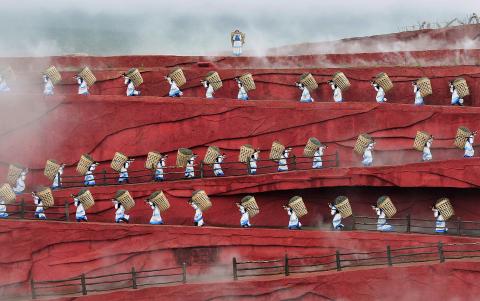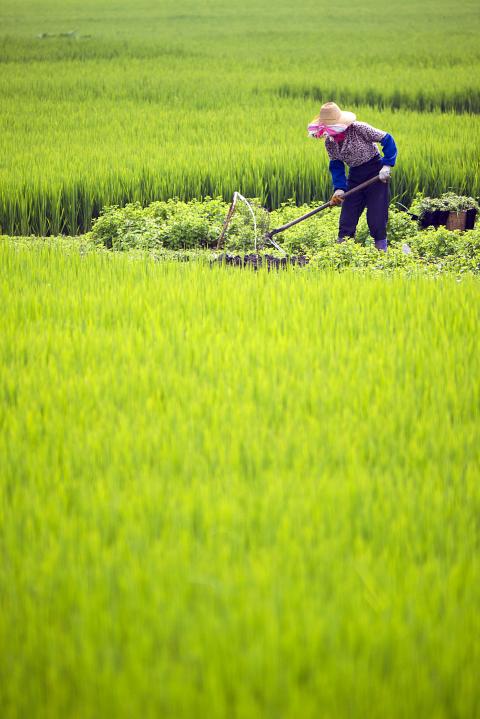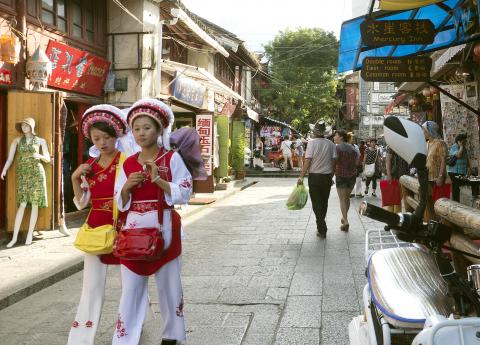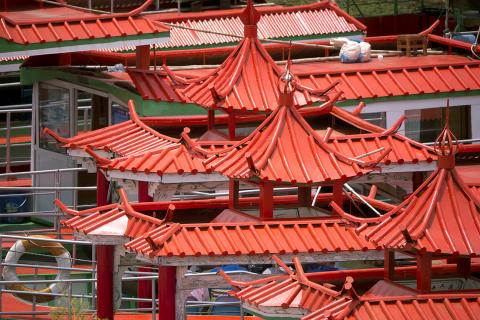There are few places in China as wild and beautiful as the Three Parallel Rivers national park. Deep in the Meili Xue Shan mountain range, in the remote northwestern corner of Yunnan, close to the border with northern Burma, it’s straight out of Lost Horizon by James Hilton. Soaring, glaciated peaks, Tibetan Buddhist monasteries floating in the clouds, lush terraced valleys and virgin Himalayan forest all collect in this area which, according to UNESCO, is “one of the richest temperate regions of the world in terms of biodiversity.” It’s a designated world heritage site and covers more than 960,000 hectares, with buffer zones almost the same size.
Only one thing had held me back from visiting this extraordinary area and that was the thought of remote Chinese hotels. Anyone who has stayed at tired government-run places with their dodgy plumbing and questionable bed linen will understand my reticence.
This May, however, Songtsam lodges announced the opening of two new boutique hotels, in Benzilan on the Jinsha River, and further north in the Meili mountains near Deqin. The latter is about 80km from the Tibetan border.

Photo: Reuters
Songtsam also has two comfortable hotels in the area now known as Shangri-la. (In 2001, in a canny move to encourage tourism to this remote spot, the Chinese government renamed the region of Zhongdian after the fictional remote utopian lamasery in Hilton’s book. The ploy appears to have worked.)
Songtsam is now opening a series of small lodges in some of the most scenic parts of this region, forming a circuit that can be done as a package including local guides and drivers. The lure of stylish rooms and heady Tibetan vistas was irresistible.
I set off with my husband early last month, hoping for clear, cold weather and mountains clad in scarlet and gold forests. Since Meili is 3,600m above sea level, we spent a few days in Lijiang (2,400m), another UNESCO site, to acclimatize before driving for six hours along the now popular route to Shangri-la, via the spectacular Tiger Leaping Gorge. The region is home to around 25 ethnic groups, including Naxi, Yi and Tibetan people.

Photo: Reuters
As we climbed ever higher on twisting mountain roads, we left behind the lush Naxi farmland and pretty Yi villages clinging to the lower hillsides, and entered what was once Tibet. It officially became Yunnan when the Chinese government redefined the borders in 1951. Stupas and fluttering prayer flags clung to rocky outcrops, and sturdy white Tibetan houses dotted the landscape. You know you’re nearing Shangri-la when the landscape flattens out into rolling pasture surrounded by mountain peaks.
At 3,300m our hotel, the Songtsam Shangri-la, looks over the back of the towering Songzangling monastery — the largest in Yunnan. Once home to 4,000 monks, the monastery is undergoing a massive restoration. Tourism is funding the gold-leaf-clad roofs, but it is also creeping into the more remote regions of Yunnan.
Even here, where the Milky Way still forms a great smudge across the night sky, you can see the huge concrete pillars of a new highway being built around a far-away mountain. But it’s easy to forget modernity as you lie in a snug, futon-like Tibetan bed and drift to sleep to the sound of bells tinkling from a herd of zos, a crossbreed of cow and yak, grazing in a frosty meadow.

Photo: EPA
From Shangri-la onwards, my feelings flipped back and forth from wonder at the sheer natural beauty to horror at the power of 21st-century industrial development. Large tracks of road were being rebuilt, in a bumpy hell of swirling dust, truck fumes, temporary cement factories and ragged roadside habitation. Huge scars were cut into the thickly wooded mountains as the road was excavated and rubble tipped down the side of the mountain.
In a year or two, this mountain highway will bring 21st-century benefits to isolated communities, but it will take time for the landscape to recover and you can’t escape a sense that the life you see will soon vanish.
The vistas changed with every twist and turn of the road. One minute a verdant, terraced valley dotted with houses stretched out below. This was the Nixi valley, where in dark, dusty rooms, each household still makes ornate black pottery. The next minute we were climbing into forests of Yunnan pine and spruce that are carpeted with tiny, intensely colored alpine flowers.

Photo: EPA
As the morning drifted by, we drove through idyllic valleys where plum-colored birds perched on telephone wires and every house was surrounded with roses, geraniums and marigolds. Groves of willow and walnut trees sheltered pretty terraces of vines, maize, pumpkins and potatoes. Chickens, pigs and small children ran free — boys and girls in rural communities are sent away to huge Chinese boarding schools once they reach the age of 7. Farmers doggedly carried baskets of manure on their backs from farmyard to field. Animals live at the bottom of Tibetan houses and food is stored at the top. People may not be hungry, but this is farming at its most basic.
After three hours we stopped at Benzilan, the first of the new Songtsam lodges. The air was warm in this sheltered valley and we sat under a wisteria and gazed out over farmland before visiting the village. We’d seen brooks tumbling down every valley, and here one powered a little wooden threshing wheel. Animals rootled along the road, and each house had maize, marigolds, pine kernels, garlic and chillies drying in the autumn sun. Back at the hotel, we put on Chinese slippers and ate tiny, crispy bamboo skewers of sesame-coated yak and spiced steamed pumpkin and potato with Tibetan bread.
Our bedroom was simple but comfortable. At dawn, a villager walked clockwise around a white stupa, set high up over the valley. Smoke curled up into the pink sky from the newly lit pine needles in an incense burner. Tibetan Buddhism is an integral part of life here, and the catchy soundtrack of religious songs written by a famous 17th-century Tibetan lama accompanied our drive.

Photo: EPA
As we passed through further road works, I thought about a meeting I’d had back in Lijiang with Lushan Jizhen He, who works for the Nature Conservancy in the Three Parallel Rivers region. I’d quizzed her about the pressures on natural resources from wood-felling, and efforts to protect endangered species such as the snub-nosed Yunnan monkey and the black-necked crane. She had exuded positive energy as she outlined a raft of preventive strategies aimed at changing local practices, such as outlawing poaching and illegal logging, introducing cheap sustainable power, education and eco-tourism.
I had been a little skeptical, having seen men selling hawks for hunting in the mountains and an abundance of furs for sale — even though our guide had assured me the latter were farmed. But this journey was changing my perspective. Everywhere we went, we saw solar water heaters and biogas being used in place of wood. Trees had been planted on mountains laid bare by deforestation. Apparently even the monks preach that hunting was anti-Buddhist.
It’s the old dilemma: How do you improve life for the very poor, while at the same time protecting the environment? Perhaps tourism could open a door to further environmental protection. Songtsam lodges are working hand in hand with NGOs around the world to help educate their staff and their families, providing them with new, more sustainable ways of earning money.
Suddenly, just below more road excavations, we came across the ethereal 17th-century Dong Zhu Lin monastery, which seemed to float above a deep valley. Wandering through its richly painted halls, I understood how different Tibetan Buddhism is from other Buddhist schools. Graphic shamanistic paintings cover its walls, while the statues are more like Hindu gods than Buddhas. There were monks chanting in the main hall while others delicately tapped out brilliantly toned pigments to create a richly colored mandala nearby. Outside, ravens circled and the wind rang the temple roofs bells.
By the time we entered the Baimang Snow Mountain nature reserve it was impossible not to be swept away by the scenery. Glistening, snowy peaks towered over the rolling highland moors of copper-leafed wild azaleas, which in May form a sea of flowers. Monolithic rusty purple rocks jutted at odd angles high above us as we reached a barren high pass, marked by a thousand prayer flags.
Finally, we descended to Songtsam Meili at Deqin, amid bubbling streams and wild woods of rhododendrons, berberis and pines draped in lichen. The forest shimmered scarlet, gold and dark green in the brilliant light. We stepped into the warm comfort of the stone lodge — all wood stoves, rare old rugs and vases of wild berries — but our eyes were constantly drawn to the view.
Every one of the 17 rooms looks on to the sacred Meili Snow Mountain (Kawagebo in Tibetan). As we sipped our sweet ginger tea, I felt that this is why we travel. Before me lay the delicious possibility of clambering up the mountain behind the hotel to see yaks grazing in a meadow or riding up to the Mingyong glacier. For the time being, I was content to gaze at the snowy Tibetan mountains rising out of the clouds. As I watched, they glowed pink in the setting sun before turning silver in the moonlight.

Jan. 6 to Jan. 12 Perhaps hoping to gain the blessing of the stone-age hunter-gatherers that dwelt along the east coast 30,000 years ago, visitors to the Baxian Caves (八仙洞) during the 1970s would grab a handful of soil to bring home. In January 1969, the nation was captivated by the excavation of pre-ceramic artifacts and other traces of human habitation in several caves atop a sea cliff in Taitung County. The majority of the unearthed objects were single-faced, unpolished flake tools fashioned from natural pebbles collected by the shore. While archaeologists had found plenty of neolithic (7,000 BC to 1,700

When the weather is too cold to enjoy the white beaches and blue waters of Pingtung County’s Kenting (墾丁), it’s the perfect time to head up into the hills and enjoy a different part of the national park. In the highlands above the bustling beach resorts, a simple set of trails treats visitors to lush forest, rocky peaks, billowing grassland and a spectacular bird’s-eye view of the coast. The rolling hills beyond Hengchun Township (恆春) in Pingtung County offer a two-hour through-hike of sweeping views from the mighty peak of Dajianshih Mountain (大尖石山) to Eluanbi Lighthouse (鵝鑾鼻燈塔) on the coast, or

Her greatest fear, dormant for decades, came rushing back in an instant: had she adopted and raised a kidnapped child? Peg Reif’s daughter, adopted from South Korea in the 1980s, had sent her a link to a documentary detailing how the system that made their family was rife with fraud: documents falsified, babies switched, children snatched off the street and sent abroad. Reif wept. She was among more than 120 who contacted The Associated Press this fall, after a series of stories and a documentary made with Frontline exposed how Korea created a baby pipeline, designed to ship children abroad as quickly as

Famed Chinese demographer Yi Fuxian (易富賢) recently wrote for The Diplomat on the effects of a cross-strait war on demography. He contended that one way to deter the People’s Republic of China (PRC) is by putting the demographic issue front and center — last year total births in the PRC, he said, receded to levels not seen since 1762. Yi observes that Taiwan’s current fertility rate is already lower than Ukraine’s — a nation at war that is refusing to send its young into battle — and that its “demographic crisis suggests that Taiwan’s technological importance will rapidly decline, and